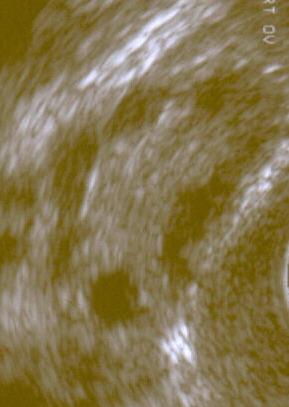PCOS
| Polycystic ovary syndrome | |
|---|---|
| Synonyms | hyperandrogenic anovulation (HA), Stein–Leventhal syndrome |
 |
|
| A polycystic ovary shown on an ultrasound image. | |
| Classification and external resources | |
| Specialty | Gynecology |
| ICD-10 | E28.2 |
| ICD-9-CM | 256.4 |
| OMIM | 184700 |
| MedlinePlus | 000369 |
| eMedicine | med/2173 ped/2155 radio/565 |
| Patient UK | Polycystic ovary syndrome |
| MeSH | D011085 |
Polycystic ovary syndrome (PCOS) is a set of symptoms due to elevated androgens (male hormones) in women. Signs and symptoms of PCOS include irregular or no menstrual periods, heavy periods, excess body and facial hair, acne, pelvic pain, difficulty getting pregnant, and patches of thick, darker, velvety skin. Associated conditions include type 2 diabetes, obesity, obstructive sleep apnea, heart disease, mood disorders, and endometrial cancer.
PCOS is due to a combination of genetic and environmental factors. Risk factors include obesity, not enough physical exercise, and a family history of someone with the condition. Diagnosis is based on two of the following three findings: no ovulation, high androgen levels, and ovarian cysts. Cysts may be detectable by ultrasound. Other conditions that produce similar symptoms include adrenal hyperplasia, hypothyroidism, and hyperprolactinemia.
PCOS has no cure. Treatment may involve lifestyle changes such as weight loss and exercise.Birth control pills may help with improving the regularity of periods, excess hair growth, and acne. Metformin and anti-androgens may also help. Other typical acne treatments and hair removal techniques may be used. Efforts to improve fertility include weight loss, clomiphene, or metformin. In vitro fertilization is used by some in whom other measures are not effective.
...
Wikipedia
